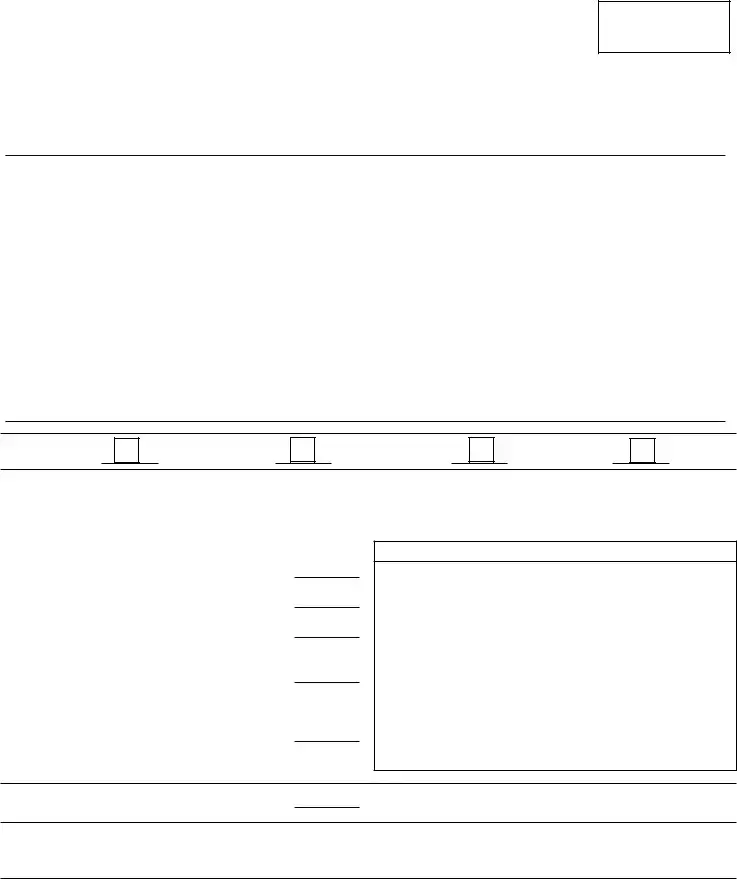New Jersey
Division of Taxation
Claim for Refund of the
Estimated Gross Income Tax Payment for the Sale of New Jersey Real Estate
For Official Use Only
Claim No.
To qualify for this refund, taxpayers must:
1)Attach a copy of the GIT/REP-3 form if they erroneously paid estimated tax and qualify for one of the exemptions listed on the GIT/REP-3; or
2)Attach documentation that they overpaid estimated tax based on calculated gain on sale of property.
Print or Type This Form.
Social Security Number(s)
Name of Taxpayer(s): |
Last |
First |
Middle |
|
|
|
|
Current Address of Taxpayer(s): |
|
Number and Street |
|
|
|
|
|
City |
|
State |
ZIP Code |
|
|
|
|
Address of Property Sold: |
|
Number and Street |
|
|
|
|
|
City |
|
State |
ZIP Code |
Use the Schedule below to determine your estimated tax liability.
Taxpayers who submitted an erroneous payment and qualify for an exemption on the GIT/REP-3, Seller’s Residency Certification/ Exemption, enter $0. A completed copy of the GIT/REP-3 Form indicating your exemption status must be attached.
Date Sold: |
|
|
|
|
|
|
|
Sale Price: |
$ |
|
|
|
|
Date Purchased: |
|
|
|
|
|
Federal Adjusted Basis: |
$ |
Percentage Owned: |
|
|
Net Gain/Loss: |
$ |
|
|
|
|
|
|
|
|
(If Net Loss - enter $0.) |
|
Estimated Gross Income Tax Payment submitted: |
$ |
Applicable Tax Year: |
|
|
|
$ |
** Estimated Tax Liability Due: |
|
|
Tax Rate Table
Net Gain |
But Not |
|
|
|
Estimated |
Over |
Over |
Multiply |
Net Gain |
By |
Tax Liability |
$0 |
$20,000 |
x |
|
0.014 |
|
$20,000 |
$35,000 |
x |
|
0.0175 |
|
$35,000 |
$40,000 |
x |
|
0.035 |
|
$40,000 |
$75,000 |
x |
|
0.05525 |
|
$75,000 |
$500,000 |
x |
|
0.0637 |
|
$500,000 |
$1,000,000 |
x |
|
0.0897 |
|
$1,000,000 |
and over |
x |
|
0.1075 |
|
Amount of Refund Claim: |
$ |
Additional Information may be requested in order to complete your claim for a refund. The Division must have a record of receiving the “Estimated Gross Income Tax Payment submitted” before your claim can be processed.
**Payment of the Estimated Tax Liability does not relieve you of your responsibility to file the required return, nor does it close the tax year covered. The tax year remains open until the required return has been filed and accepted; all tax, penalties, and interest charges have been paid; and the statutory audit period has expired.
Appointment of Taxpayer Representative
If this form is being prepared by anyone other than the taxpayer(s), an Appointment of Taxpayer Representative must be included.
Under penalties of perjury, I declare that I have examined this claim, and to the best of my knowledge and belief, it is true, correct, and complete. Declaration of preparer is based on all information of which preparer has any knowledge.
Signature of Claimant(s)/Preparer: |
|
Date: |
|
If the preparer of this claim has been paid, indicate the firm’s name, address, the firm’s federal EIN and the preparer’s Social Security number, federal identification number, or federal preparer tax identification number.
Firm’s Name:
Firm’s Address:
Preparer’s SS # or Federal PTIN:
Preparer’s Federal EIN:
Mail this claim form along with the Settlement Statement (HUD-1) or Closing Disclosure form to:
Division of Taxation
Taxpayer Accounting Branch
P.O. Box 046
Trenton, N.J. 08646-0046

Instructions for Form A-3128
Note: Use this form to claim a refund. Do not use form GIT/REP-4 to claim a refund.
1.This form is to be completed by nonresident individuals, estates, or trusts to claim a refund of estimated Gross Income Tax payment paid under provisions of N.J.S.A. 54A:8-8 through N.J.S.A. 54A:8-10. This form can only be filed with the Division of Taxation after the recording of the deed with the county clerk.
2.Separate forms must be used for each taxpayer, except for husband and wife who file jointly.
3.Include taxpayer’s current address or address where refund should be mailed.
4.Include the address of property sold and the amount of refund being requested.
5.Check box indicating type of property use.
6.Include the date of sale, sale price, date of purchase, federal adjusted basis, percentage owned, and net gain/loss of the property sold.
7.Calculate and enter the estimated tax liability using the table provided on the form. Taxpayers who submitted an erroneous payment and qualify for an exemption on the GIT/REP-3 form, Seller’s Residency Certification/Exemption, enter $0. A completed copy of the GIT/REP-3 indicating your exemption status must be attached.
Example:
Date Sold: 2/4/20 |
Sale Price: |
$315,000 |
Date Purchased: 9/21/16 |
Federal Adjusted Basis: |
$279,000 |
Percentage Owned: 100% |
Net Gain/Loss: |
$36,000 |
|
(If Net Loss, enter $0.) |
|
|
|
Estimated Gross Income Tax Payment submitted: |
$6,000 |
** Estimated Tax Liability Due: |
|
$1,260 |
Amount of Refund Claim: |
|
$4,740 |
Tax Rate Table
Net Gain |
But Not |
|
|
|
Estimated |
Over |
Over |
Multiply |
Net Gain |
By |
Tax Liability |
$0 |
$20,000 |
x |
|
0.014 |
|
$20,000 |
$35,000 |
x |
|
0.0175 |
|
$35,000 |
$40,000 |
x |
$36,000 |
0.035 |
$1,260 |
$40,000 |
$75,000 |
x |
|
0.05525 |
|
$75,000 |
$500,000 |
x |
|
0.0637 |
|
$500,000 |
$1,000,000 |
x |
|
0.0897 |
|
$1,000,000 |
and over |
x |
|
0.1075 |
|
8.Include the estimated Gross Income Tax payment submitted. Payment of the Estimated Tax Liability does not relieve you of your responsibility to file the required return nor does it close the tax year covered. The tax year remains open until the required return has been filed and accepted; all tax, penalties, and interest charges have been paid; and the statutory audit period has expired.
9.Enter the amount of the net refund being claimed.
10.Whenever an agent on behalf of the taxpayer executes a claim, an Appointment of Taxpayer Representative specifically authorizing such agent to act on behalf of the taxpayer must accompany the claim for refund form.
11.Mail this claim for refund along with the Settlement Statement (HUD-1) or Closing Disclosure form to:
New Jersey Division of Taxation
Taxpayer Accounting Branch
PO Box 046
Trenton, NJ 08646-0046
12.Failure to complete all required lines on Form A-3128 or to attach required documentation will result in the claim being rejected as incomplete. Incomplete claims will be returned. Claims will not be deemed filed until the Division of Taxation receives a properly completed claim form along with the required documentation.


